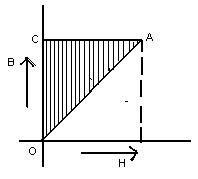Determination Of Hystersis Loss
Determination Of Hystersis Loss Assignment Help | Determination Of Hystersis Loss Homework Help
Determination of Hystersis Loss
The hysteresis loss can be determined by determining the area of the hysteresis loop, provided the shape of the loop is known.
The area of the loop should be measured in units of H and B i.e. in mp-turns/metre and Wb/m2 respectively. To measure the area of the loop in units of H and B, the area of the loop measured in square metres may be multiplied by the scales of H and B.

For example if one metre represents H = x AT/m
and one metre represents B = y wb/m2
The hytersis loss = Area of the loop in square metres X x X y Joules/m3/cycle
Hysteresis loss can be determined by Steinmetz according to which hysteresis loss per cubic metre per cycle of magnetization of a magnetic material depends upon the maximum value of the flux density and the magnetic quality of the material.
Hysteresis loss ά (Bmax)1-6 J/m/cycle =η(Bmax)1-6 J/m2/cycle
Total hysteresis loss per second = η(Bmax)1-6 fV J/S or walts
where η is constant for a given specimen and a given range of flux density and is known as steimetz hysteresis coefficient, f is the frequency of reversal of magnetization and V is the volume of the magnetic material in cubic metres.
If it is assumed that the ring is of non-magnetic substance, then induction density B = μo H and hysterisis loop for such a specimen will be a straight line passing through the origin and energy expended in increasing induction density from Zero to Bmax

Energy expended per cubic metre of volume

For more help in Determination of Hystersis Loss click the button below to submit your homework assignment
The area of the loop should be measured in units of H and B i.e. in mp-turns/metre and Wb/m2 respectively. To measure the area of the loop in units of H and B, the area of the loop measured in square metres may be multiplied by the scales of H and B.
For example if one metre represents H = x AT/m
and one metre represents B = y wb/m2
The hytersis loss = Area of the loop in square metres X x X y Joules/m3/cycle
Hysteresis loss can be determined by Steinmetz according to which hysteresis loss per cubic metre per cycle of magnetization of a magnetic material depends upon the maximum value of the flux density and the magnetic quality of the material.
Hysteresis loss ά (Bmax)1-6 J/m/cycle =η(Bmax)1-6 J/m2/cycle
Total hysteresis loss per second = η(Bmax)1-6 fV J/S or walts
where η is constant for a given specimen and a given range of flux density and is known as steimetz hysteresis coefficient, f is the frequency of reversal of magnetization and V is the volume of the magnetic material in cubic metres.
If it is assumed that the ring is of non-magnetic substance, then induction density B = μo H and hysterisis loop for such a specimen will be a straight line passing through the origin and energy expended in increasing induction density from Zero to Bmax
Energy expended per cubic metre of volume
For more help in Determination of Hystersis Loss click the button below to submit your homework assignment